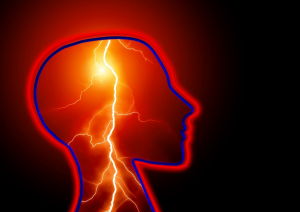Guest Blog By Dr. Brent Wells
Photophobia, or light sensitivity, can be a problem in and of itself. But, it’s also common in people who experience headaches, especially migraine headaches.
The etymological definition of photophobia technically means fear of light, but that’s not what it means in the medical community. Instead, health care providers consider photophobia to be a sensitivity to light that can cause pain or discomfort.
Symptoms of photophobia
According to research published in Health, photophobia can actually aggravate headaches. This is an abnormal reaction because the level of light causing discomfort isn’t technically enough to bother the human eye.
Let’s take a look at the abnormality of photophobia during migraines. A typical sunny, cloudless day can have lux measurements in the tens of thousands. According to the study in Health, the control subjects started to report discomfort at 23,000 lux. People who suffered from migraines had discomfort beginning around 500 lux.
 Patients who experience migraines and tension or cluster headaches generally describe intense light as glaring or painful. When health care providers examine patients to diagnose headaches and migraines, these comments are symptoms of the diagnoses.
Patients who experience migraines and tension or cluster headaches generally describe intense light as glaring or painful. When health care providers examine patients to diagnose headaches and migraines, these comments are symptoms of the diagnoses.
Interestingly, photophobia happens on both sides of the head, even if the headache is happening only on one side.
Researchers in the Health study found that photophobia occurs at different levels with different types of headaches. People who experience tension headaches don’t always experience photophobia, while people who experience cluster headaches only experience photophobia during the cluster period. Therefore, people who suffer from migraine headaches experience photophobia during different stages of the headache.
Physical causes of photophobia
Researchers continue to look for physical reasons why photophobia happens so frequently with migraine and other headaches. In a study published in Current Opinion in Neurology, researchers looked at patients who are blind and experience migraines.
They looked at a retino-thalamo-cortical pathway to see if the trigeminovascular neurons were involved in photophobia during migraines. Trigeminal neurons are the nerves around the head that are responsible for sensory functions and motor functions.
 According to this study, 80% of migraine sufferers who have normal vision experience photophobia to a degree that exacerbates their headaches. The rationale for this study involved the reasoning that light signals join the trigeminovascular pathway from the retina.
According to this study, 80% of migraine sufferers who have normal vision experience photophobia to a degree that exacerbates their headaches. The rationale for this study involved the reasoning that light signals join the trigeminovascular pathway from the retina.
Researchers looked at blind migraine sufferers because their damaged optic nerves no longer are able to detect light, so they shouldn’t be able to suffer from photophobia. Their findings showed that a functioning optic nerve was necessary for photophobia to occur, though the exact processes remained unclear.
Preliminary conclusions say that photophobia and its related pain seem to involve the trigeminal nerve and its spinal trigeminal nucleus. Unfortunately, this study didn’t involve treating photophobia; it only attempted to better understand what physiology was involved in causing it.
As researchers continue to look for the cause of photophobia, new discoveries unfold. In a study published in the Survey of Ophthalmology, researchers understand that photophobia not only happens to migraine sufferers but also people who have blepharospasm – an abnormal contraction of the muscles that control the eyelids – as well as people with traumatic brain injuries.
When looking at the similarities between the groups of people, researchers recognized that the “photosensitive retinal ganglion cells play a key role in the pathophysiology of photophobia.” Once researchers are able to narrow down the exact cause and neural pathways of the problem, they’ll be able to find treatments and preventative solutions for photophobia.
Medical treatment options for photophobia
Since photophobia affects 80% to 90% of migraine sufferers, it’s important that effective treatment becomes available. Photophobia happens during two stages of migraines, during the attack and between them as well. The theories behind treatments hinge on the fact that photoreceptors in the eye have to involved due to light being the stimulus for the pain response.
The human eye has cones, rods, and intrinsically photosensitive retinal ganglion cells. In a study published in Translational Neurodegeneration, it’s the intrinsically photosensitive retinal ganglion cells that are involved in photophobia. This was a new study that focused on blind migraine sufferers who, unlike previous studies, did report having photophobia. In this case, because blind people don’t have functioning rods or cones, researchers were able to isolate the cause of photophobia as the intrinsically photosensitive retinal ganglion cells. Within the retinal ganglion cells, there is the melanopsin signaling system, which is involved in the pathology of photophobia.
 Despite the current theory that the melanopsin signaling system is involved in photophobia, there’s not yet a prescription medication available for photophobia. However, there are treatment options for migraine sufferers that reportedly help reduce photophobia.
Despite the current theory that the melanopsin signaling system is involved in photophobia, there’s not yet a prescription medication available for photophobia. However, there are treatment options for migraine sufferers that reportedly help reduce photophobia.
They include beta-blockers, anticonvulsants, and calcium channel blockers. Researchers have also found another treatment option that also works for blepharospasm: botulinum neurotoxin. This medication appears to ease some of the discomfort that comes with photophobia in migraine sufferers, too.
Holistic treatment options for photophobia
On the other hand, those who suffer from photophobia may opt for all-natural and holistic treatment options. There are several reasons why a patient might go this route.
First, migraine sufferers often struggle to find the right medication that doesn’t also present side effects. In addition, a patient might want to try holistic solutions that can naturally ease their symptoms, without relying on medication. Sometimes these solutions can prevent migraines from even starting – another benefit over medical treatment options.
Furthermore, studies show that holistic solutions are effective and safe. Two of the best all-natural solutions are special glasses and chiropractic care. Both of these options will help ease symptom while avoiding the side effects and costs of medications.
First, those who suffer photophobia may already choose to wear dark sunglasses at all times, even indoors. Those who suffer photophobia should use FL-41 lens rather than the typical gray lenses that come with sunglasses. The FL-41 lens has a unique color – a purplish, berry color – that filters out blue and green wavelengths. The lenses can also improve visual acuity and are recommended for people who use computers regularly, too. (Read more about these lenses here.)
Finally, chiropractors—such as Better Health Chiropractic in Wasilla—have also been able to help patients with photophobia. In a study published in the Journal of Chiropractic Medicine, patients responded well to treatment with the Gonstead method. After 11 treatments in 9 weeks, patients reported that their migraines diminished. With diminishing migraines, photophobia decreases, too. In fact, six months after the final treatment, migraines hadn’t returned. More research needs to be conducted, but early studies and clinical experience show positive results.
About the author, Dr. Brent Wells
Serving Wasilla, Anchorage, and the surrounding communities, Dr. Brent Wells offers patient-centered, personalized, and innovative chiropractic care. A California native, Dr. Wells earned a bachelor’s of science degree from the University of Nevada. He then attended Western States Chiropractic College in Portland, Oregon. In 1998, he and his wife Coni moved to Alaska and opened Better Health Chiropractic in Wasilla. He is a proud member of the American Chiropractic Association and the American Academy of Spine Physicians.
Ready for relief?
In the Ultimate Migraine Relief Course you will master the top 10 relief techniques that calm your nervous system fast.




Thanks so much for all this information. I thank God I don’t have this or chronic migraine. I’ve only had a couple in my life, and they left me thanking my lucky stars.
I feel so sorry for people who suffer from migraines. My sister being one of them. They are debilitating! She can’t eat or do anything when she has them and she gets them at least 2x a month if not more. I am sure sun affects her too when they happen. Ugh, She’s tried everything.
Thanks for sharing the story about your sister. Let us know if there’s anything we can do to help.
I know phobias can be really crippling. I am glad you listed holistic options to deal with phobias.
I am glad this list helps you!
This is a very nice topic to discuss. Especially when it is not too common. It’s all about awareness!
Great to know about photophobia which I had no idea about. My wife has recently started getting migraine attacks and this information may be very useful.
Glad it was helpful. Would love to hear an update from her!
My mom suffers from migraines I’ll be passing this along to her 🙁
Thanks for sharing this to your mom. Hope it will help her to find some relief.
I have a friend who suffers from this. I always feel so bad for her because it looks so rough.
Oh yes. I know about this too well. When mine get bad, I go under the covers.
My migraines typically make me most sensitive to movement. Almost like I am giant and every step I take vibrates my head. Any amount of exertion is a challenge. I can’t imagine if light was also a factor for me.
I am so sorry to hear this. Feel free to contact us if you need any help,
This is such an informative post! This must be absolutely horrendous to suffer from this type of migraine. I don’t know if most people who have never experienced one, truly know how painful they can be.
Thanks for recognizing that light sensitivity is an issue. I do suffer from that with my Chronic Migraine. My Ocular Migraines have been triggered by something as simple as walking into a store that’s lights are too bright for me.
I keep sunglasses with me at all times., & yes, I wear them on overcast days.
I hear you, Glynis, I used to be set off by store lighting or bright sunny days, too. Luckily that has really toned down as eliminated other sources of stress in my body so that now I notice the bad lighting and try to avoid it (just like I would avoid air fresheners because they aren’t healthy), but don’t have to fear them! This analogy may help explain how our sensitivities are connected: https://www.engineeringradiance.com/bathtub-theory/
Thanks for this article. There’s some really great information here plus some good suggestions to help. I plan to share this information with clients who struggle with migraines.